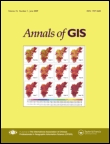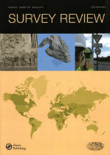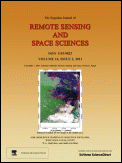
ISPRS International Journal of Geo-Information
Scope & Guideline
Connecting insights, shaping the future of geoinformation.
Introduction
Aims and Scopes
- Geospatial Data Analysis:
The journal emphasizes the analysis of geospatial data using advanced statistical and computational methods, including machine learning and data mining techniques. - Remote Sensing Applications:
It explores applications of remote sensing technologies for environmental monitoring, land use change detection, and disaster response, highlighting innovative methodologies and case studies. - Urban and Regional Planning:
The journal includes research related to urban studies, including land use planning, transportation networks, and the social implications of urbanization. - Environmental Monitoring and Management:
Research on ecological assessments, biodiversity monitoring, and sustainable resource management is a core area, focusing on the application of geospatial technologies for environmental conservation. - Public Health and Safety:
The journal presents studies that link geospatial analysis with public health, including disease mapping and analysis of health service accessibility. - Innovative Geospatial Technologies:
It highlights advancements in geospatial technologies, including GIS, GPS, and emerging technologies like blockchain and artificial intelligence, fostering interdisciplinary collaboration.
Trending and Emerging
- Machine Learning in Geospatial Analysis:
There is a significant increase in the application of machine learning algorithms for analyzing geospatial data, reflecting the growing importance of AI in the field. - Integration of Multi-Source Data:
Research integrating multiple sources of data, including satellite imagery, social media, and sensor data, is on the rise, showcasing innovative approaches to complex geospatial questions. - Climate Change and Environmental Sustainability:
Papers addressing the impacts of climate change and strategies for environmental sustainability are becoming more common, indicating a broader societal focus on ecological issues. - Smart City Technologies:
The exploration of smart city technologies, including urban mobility solutions and data-driven urban planning, is trending, highlighting the intersection of geospatial science and urban innovation. - Health Geography and Pandemic Response:
Emerging studies focusing on health geography, particularly in the context of pandemic responses and public health analytics, reflect the journal's commitment to addressing pressing global health issues.
Declining or Waning
- Traditional Cartography:
There is a noticeable decline in studies focusing on traditional cartographic methods, as the field increasingly embraces digital and interactive mapping technologies. - Static Data Models:
Research centered on static data models and methodologies has decreased, with a shift towards dynamic and real-time data processing techniques. - Basic GIS Applications:
While GIS remains a significant focus, the journal has seen a decline in papers addressing basic GIS applications, as more complex and integrated applications gain traction. - Theoretical Frameworks without Practical Applications:
There has been a reduction in publications that explore theoretical frameworks without accompanying practical applications, as the journal increasingly favors studies with real-world relevance. - Local Case Studies:
The prevalence of localized case studies has decreased in favor of broader, global analyses that leverage large datasets and comparative approaches.
Similar Journals

Geodetski List
Connecting Experts in Geospatial Research and DiscoveryGeodetski List is a prestigious journal published by the Croatian Geodetic Society, focusing on the field of geodesy within Earth and Planetary Sciences. Since its inception, the journal has become a vital resource for researchers, professionals, and students who are keen to explore advancements and innovations in geodetic science. With a broad scope encompassing theoretical and applied aspects, Geodetski List provides a platform for disseminating research findings, case studies, and technical developments, facilitating knowledge exchange among geospatial experts. The journal has been indexed from 1979 to 1983, 1985, and from 2008 to 2024, maintaining a respectable standing within the academic community, as evidenced by its classification in the Q3 quartile for 2023. Although not open access, the journal represents an invaluable asset for its audience, aiding in the understanding of geodetic practices, methodologies, and technological advancements. Located in Zagreb, Croatia, it is dedicated to promoting robust scholarship in geodesy and its applications.

Spatial Information Research
Empowering interdisciplinary collaboration in spatial information.Spatial Information Research, published by SPRINGER SINGAPORE PTE LTD, is a prominent journal committed to advancing the interdisciplinary field of spatial information science. With an ISSN of 2366-3286 and an E-ISSN of 2366-3294, this journal serves as a crucial platform for disseminating research findings from 2016 to 2024, focusing on applications in Artificial Intelligence, Computer Science Applications, and Geography, among others. Ranking in the Q2 and Q3 quartiles across various categories, it showcases impactful research that informs geographic planning, environmental sciences, and computational methodologies. The journal's rigorous peer-review process ensures high-quality contributions that offer insights for both academic scholars and industry professionals. While retaining exclusive access options, Spatial Information Research is a vital resource for researchers eager to explore the complexities of spatial data and its applications in real-world scenarios.

Annals of GIS
Transforming Data into Actionable InsightsWelcome to the Annals of GIS, a leading academic journal published by Taylor & Francis Ltd, dedicated to advancing the field of Geographic Information Science and its applications. With an ISSN of 1947-5683 and an E-ISSN of 1947-5691, this Open Access journal has been ensuring wide accessibility since 2019, thereby bolstering the dissemination of knowledge in areas such as remote sensing, spatial analysis, and geoinformatics. Hailing from the United Kingdom, the journal ranks impressively within its categories, achieving a Q2 status in Computer Science Applications and a prestigious Q1 ranking in Earth and Planetary Sciences for 2023, placing it in the top 10% among its peers. With a focus on innovative research spanning from 2009 to 2024, the Annals of GIS serves as a vital platform for researchers, professionals, and students alike, providing insights and fostering discussions that push the boundaries of geographic technologies and their real-world applications.

Journal of Geovisualization and Spatial Analysis
Bridging Disciplines with Cutting-Edge ResearchJournal of Geovisualization and Spatial Analysis, published by SpringerNature, is an influential open-access journal specializing in the cutting-edge fields of geovisualization, spatial analysis, and their application in earth sciences and geography. Since its inception in 2017, this journal has established a prominent stance with a high impact factor and prestigious Q1 rankings across multiple categories, including Computers in Earth Sciences, Earth and Planetary Sciences (miscellaneous), and Geography, Planning and Development. The editorial board is committed to advancing innovative research and methodologies, providing a platform for scholars to disseminate their findings globally. With impressive Scopus rankings—placing it in the top percentiles among its peers—the journal serves as a vital resource for researchers, professionals, and students keen on understanding spatial data and its implications for geographic science. Its emphasis on rigorous peer review and rapid publication enhances accessibility to substantive research, thus fostering knowledge sharing within the scientific community. Based in Switzerland, the journal promotes a collaborative environment for interdisciplinary studies, making it an essential read for anyone involved in spatial analysis research.

ACM Transactions on Spatial Algorithms and Systems
Advancing the Frontiers of Spatial Algorithms.ACM Transactions on Spatial Algorithms and Systems is a premier academic journal published by the Association for Computing Machinery, focusing on advancements and innovations in spatial algorithms and their implementations across various domains. With an ISSN of 2374-0353 and E-ISSN 2374-0361, this journal showcases cutting-edge research in areas such as Discrete Mathematics, Geometry, and Information Systems, and consistently ranks in the Q2 category across multiple relevant fields as per the 2023 metrics. The journal is particularly notable for its impactful contributions to computer science applications, modeling and simulation, and signal processing, as evidenced by its impressive Scopus rankings. While it does not operate on an open-access model, ACM Transactions prioritizes accessibility to the latest findings for researchers, professionals, and students eager to explore and engage with spatial algorithms. By publishing high-quality, peer-reviewed articles since its establishment in 2015, the journal plays a critical role in advancing knowledge and fostering innovation in spatial systems research, making it an essential resource for academics and practitioners looking to stay at the forefront of this dynamic field.

Applied Geomatics
Harnessing the power of geomatics for global impact.Applied Geomatics is an esteemed academic journal published by SPRINGER HEIDELBERG, dedicated to advancing the field of geomatics through rigorous research and innovative applications. With an ISSN of 1866-9298 and an E-ISSN of 1866-928X, this journal has gained a prominent standing in multiple disciplines, achieving a Q2 ranking in esteemed categories such as Earth and Planetary Sciences, Engineering, Environmental Science, and Geography. The journal's convergence of research from 2009 to 2024 positions it as a vital resource for both scholars and practitioners seeking to understand and leverage geomatic technologies in real-world scenarios. Located in Germany, Applied Geomatics not only contributes to theoretical advancements but also to practical methodologies that address current environmental challenges. Its accessibility and relevance ensure that the findings discussed within its pages are pivotal for professionals, researchers, and students alike, fostering collaboration and innovation within the field.

Geosaberes
Bridging Theory and Practice in Geography ResearchGeosaberes is a pivotal open-access journal published by the Geography Postgraduate Program at the Federal University of Ceará, dedicated to advancing the field of geography through the dissemination of high-quality research and critical discourse. Since its inception in 2010, this journal has actively supported the global academic community by providing accessible research findings and theoretical insights that contribute to the understanding of geographical phenomena. With a strong focus on interdisciplinary studies and local contexts, Geosaberes invites contributions from both emerging and established scholars, fostering dialogue and collaboration among researchers, professionals, and students worldwide. The journal strives to publish articles that reflect innovative ideas, enhance academic understanding, and promote sustainable practices in geography, thereby solidifying its role as an influential platform within the field.

SURVEY REVIEW
Exploring Innovations in Earth and Planetary SciencesSURVEY REVIEW is a distinguished journal published by Taylor & Francis Ltd, focusing on a diverse range of disciplines including Civil and Structural Engineering, Computers in Earth Sciences, and Earth and Planetary Sciences. With an ISSN of 0039-6265 and an E-ISSN of 1752-2706, this journal has been a vital resource for scholarly communication since its inception in 1963. Positioned within the Q2 and Q3 quartile categories according to the latest rankings, it is recognized for its significant contributions to advancing knowledge in multiple fields, specifically holding a rank of 64/159 in Earth and Planetary Sciences and 32/73 in Computers in Earth Sciences. Researchers, professionals, and students benefit from its critical insights into complex engineering and scientific challenges. Although SURVEY REVIEW is not open access, it remains a highly cited journal, making it an essential avenue for disseminating pivotal findings that impact both academia and industry practices.

International Journal of Spatial Data Infrastructures Research
Driving Progress in Geographic Information SystemsThe International Journal of Spatial Data Infrastructures Research is a prestigious, open-access publication dedicated to advancing knowledge in the field of spatial data infrastructures. Published by the European Commission, Joint Research Centre, this journal has been a vital resource since its inception in 2006, promoting innovative research that informs policy and practice in geographic information systems and spatial data management. With a robust commitment to open access, the journal ensures that critical findings are readily available to researchers, professionals, and students globally, fostering a collaborative environment for the development of spatial technologies. The journal's unique focus on spatial data infrastructures makes it an essential platform for sharing empirical studies, theoretical advancements, and practical applications, ultimately driving the evolution of smart, sustainable geospatial solutions.

Egyptian Journal of Remote Sensing and Space Sciences
Pioneering Research for a Deeper Understanding of Our UniverseThe Egyptian Journal of Remote Sensing and Space Sciences, published by Elsevier, is a premier open-access journal dedicated to advancing the fields of Remote Sensing and Space Sciences. Since its inception, the journal has gained a prominent reputation, currently holding a prestigious Q1 ranking in Earth and Planetary Sciences and placing within the top 10% of its field according to Scopus metrics. With an ISSN of 1110-9823 and an E-ISSN of 2090-2476, the journal features a diverse range of scholarly articles that explore both theoretical and practical aspects of remote sensing technologies and space science innovations, thus appealing to researchers, professionals, and students alike. Established in 2003 and fully transitioning to an open-access model in 2010, the journal aims to disseminate knowledge and foster collaboration across the globe by providing wider accessibility to groundbreaking research findings. Its commitment to quality and innovation is a catalyst for intellectual development in these dynamic and evolving disciplines.